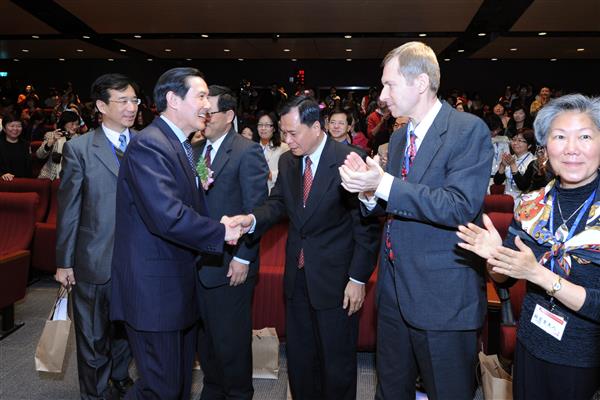News & activities
 News releases
News releases
President Ma Ying-jeou on the morning of December 18 attended the opening of the 2010 Annual Conference of the Association of Teaching Chinese as a Second Language. During remarks to the gathering, the president expressed appreciation for the efforts made by scholars, experts, and private groups to promote the learning of Chinese. He also congratulated Fu Jen Catholic University on the 85th anniversary of its founding.
Noting the increasing worldwide popularity of Chinese as a second language, President Ma remarked that about 30 million people around the globe study Chinese each day, and over 4,000 universities in over 100 nations currently offer Chinese language courses. In the United States, for example, 80 universities offer degrees in Chinese and 700 offer Chinese-language coursework. The US College Board in 2003 announced it would offer an Advanced Placement Chinese Language and Culture course starting in 2006. Former US President George W. Bush four years ago also announced the allocation of over US$100 million to promote the National Security Language Initiative, with Chinese listed as one of the five "critical need" foreign languages. The Chinese K-16 Pipeline Flagship Program is currently being implemented, and Chinese is expected to become the second most common foreign language in the United States by 2040, President Ma said.
Addressing the issue of orthodox Chinese characters versus simplified characters, the president said that traditional long-form characters have survived over thousands of years thanks to the fact they are deeply expressive. This makes it easy to learn orthodox characters and enables them to serve as an important means of preserving and promoting Chinese cultural legacy, he said.
In addition, the president commented on false reports on the Internet claiming that the United Nations (UN) had abolished the use of orthodox characters. He said that while the UN long ago adopted simplified characters as the standard, the WHO International Standard Terminologies on Traditional Medicine in the Western Pacific Region last year nevertheless decided to adopt orthodox characters for over 3,700 Chinese medical terms to overcome difficulties stemming from the fact that different countries have simplified Chinese characters in different ways. The use of orthodox characters ensures accurate interpretation of medical texts.
President Ma stressed that orthodox characters embody a culture that must be preserved. This does not mean that characters cannot be changed, but changes must be logical, and should not cut us off from our heritage. This is why he suggested that mainland China encourage its people to maintain a reading knowledge of orthodox characters while continuing to write simplified forms, and that orthodox characters be used as much as possible in published materials.
The president pointed out several ways the ROC Ministry of Education could promote Chinese language education, such as: encouraging and guiding local universities and colleges to set up Chinese as a Second Language departments or programs to cultivate good teachers; sending more Chinese language teachers to teach overseas; selecting students in Chinese as a Second Language departments at local universities and colleges to assist in teaching overseas; and providing scholarships to encourage foreign students to study Chinese in Taiwan.



